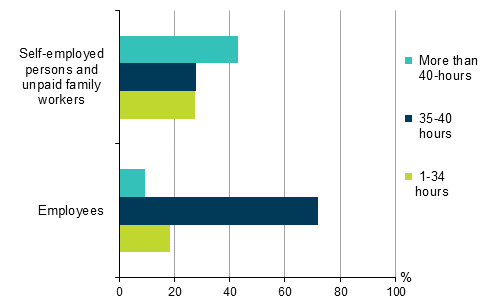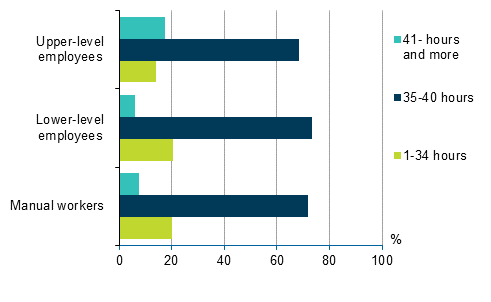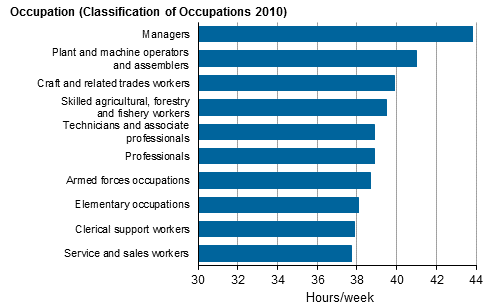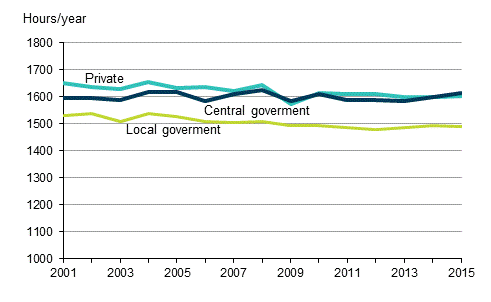3 Working time in 2015
3.1 Working times change slowly
The concepts of working hours used in the statistics are usual weekly working hours, hours actually worked per week, and hours actually worked per employed.
Usual weekly working hours refer to an employed person’s normal or average weekly working hours in the main job. Regular paid or unpaid overtime is included in the usual weekly working hours of employees. The average of usual weekly working hours is influenced by the form of working hours, i.e. whether full-time or part-time work is concerned.
Hours actually worked per week is the number of hours employed persons have worked in the survey week. Hours actually worked per week are separately inquired as concerns the main job and secondary job. Paid and unpaid overtime hours are also included. On the other hand, holidays, weekdays off and absences for other reasons (e.g. sickness) reduce the hours actually worked per week.
Hours actually worked per employed is an imputed concept, which is obtained by dividing the number of hours worked by all employed during the year by the annual average number of employed. This produces the average hours actually worked per employed. The average hours actually worked can also be calculated separately for employees.
Working hours and hours worked fluctuate according to changes in the employment rate and in the structure of the employee population. For instance, if part-time work becomes more widespread than full-time work, the average weekly working hours will decrease. Working hours also vary by industry and occupation, as well as by employer sector. Working hours change quite slowly.
3.2 Commonest working week is 35 to 40 hours
The vast majority (71%) of employees worked a usual week of 35 to 40 hours in 2015. Around ten per cent of employees worked a usual week of over 40 hours. Slightly under one-fifth of employees worked a usual week of under 35 hours. For them, usual weekly working hours were 30 to 34 hours.
Long usual weekly working hours were most widespread among self-employed persons and unpaid family workers. For 43 per cent of them, usual weekly working hours were over 40 hours. Only around one-third of self-employed persons and unpaid family workers had usual weekly working hours of 35 to 40. Good one-quarter of self-employed persons and unpaid family workers had a usual week of under 35 hours. (Figure 15.)
Figure 15. Average usual weekly working hours of employees in their main job by occupational status in 2015, %

Variations in usual weekly working hours between different employee groups were fairly small. Among employees, upper-level employees most usually had long usual weekly working hours. For one-fifth of them, usual weekly working hours were over 40 hours. One in five lower-level employees and manual workers had short usual working hours of under 35 hours per week. Short working weeks were less usual among upper-level employees. (Figure 16.)
Figure 16. Average usual weekly working hours of employees by socio-economic group in 2015, %

3.3 Men’s working week in full-time employment longer than women’s
In 2015, employees' usual weekly working hours were 36.2 hours in their main job and their hours actually worked per week were 35.0 hours in their main job. The longest weekly hours were worked by self-employed persons (including unpaid family workers), whose average usual weekly working hours in 2015 totalled 40.7 and hours actually worked per week 39.8. Hours actually worked per week are reduced by holidays and other absences and increased by worked overtime hours.
As in previous years, men's usual and actual weekly working hours were longer than women’s in 2015. By contrast, both the usual and actual weekly working hours of women working part-time were slightly longer than for men working part-time. (Table 1)
Table 1. Average of employees’ usual weekly working hours in their main job and hours actually worked per week in full-time and part-time work by sex in 2015
| Usual weekly working hours | Hours actually worked per week, hours/week | |||
| Full-time work | Part-time work | Full-time work | Part-time work | |
| Sexes, total | 39,0 | 19,5 | 37,5 | 19,8 |
| Males | 39,9 | 18,6 | 38,6 | 18,9 |
| Females | 38,1 | 20,0 | 36,2 | 20,2 |
Among the occupational groups of employees in full-time employment, managers had the longest usual weekly working hours of around 43.8 in 2015. In addition to managers, only plant and machine operators, and assemblers had usual weekly working hours of over 40. Correspondingly, service and sales workers had the shortest usual weekly working hours. (Figure 17.)
Figure 17. Average usual weekly working hours of full-time employees in main job by occupation in 2015

3.4 Annual hours actually worked per employee remained more or less unchanged in 2015
Annual hours actually worked per employee (see definition in Section 3.1) was 1,574 hours in 2015, which was almost the same as in the previous year. In the private sector and in central government, the annual hours actually worked per employee have been almost equal in recent years. Employees' annual hours actually worked in the private sector and in the central government sector increased slightly in 2015. By contrast, in the local government sector, the annual hours actually worked declined slightly from 2014. In the local government sector, the annual hours actually worked are clearly below those in other sectors. A majority of those working in the local government sector are women. (Figure 18.)
For instance, women work part-time more often than men. Two-thirds of all employees working part-time are women. Family leaves also shorten women’s hours actually worked more than men’s. In 2015, the number of hours actually worked per employed was 1,469 hours among female employees and 1,685 hours among male employees.
Figure 18. Annual hours actually worked per employee by employer sector in 2001 to 2015

Source: Labour Force Survey 2015. Statistics Finland
Inquiries: Joanna Viinikka 029 551 3796, Arto Miettinen 029 551 2963, tyovoimatutkimus@stat.fi
Director in charge: Jari Tarkoma
Updated 12.4.2016
Official Statistics of Finland (OSF):
Labour force survey [e-publication].
ISSN=1798-7857. Employment and unemployment 2015,
3 Working time in 2015
. Helsinki: Statistics Finland [referred: 12.4.2025].
Access method: http://stat.fi/til/tyti/2015/13/tyti_2015_13_2016-04-12_kat_003_en.html

